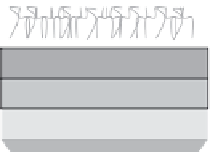Agriculture Reference
In-Depth Information
Linker layer
CM5 sensor chip
Gold layer
Glass layer
Inhibition assay
Competition assay
Antibody
Analyte
Immobilized analyte
Conjugated analyte
Fig. 20.4
Formats for inhibition and competition assays.
Inhibition
: Free analyte inhibits binding of the antibody
to the immobilized analyte on the chip. The signal generated when the antibody binds to the immobilized analyte
is inversely proportional to the concentration of free analyte in the sample.
Competition
: Free ( ) and conjugated
( ) analyte compete for binding to the immobilized antibody. The signal generated is inversely proportional to
the amount of free analyte in the sample.
between the immobilized and free antigen for antibody binding. A change in signal is
recorded, and this is inversely proportional to the amount of target molecule that remains
free in solution. An alternative method to detect analytes of interest involves a competitive
assay. In this format, the antibody is immobilized on the surface of a suitable matrix, and
the sample is mixed with a standard target molecule that has been conjugated to a large
carrier protein. This results in the sample and the conjugated standard competing for the
immobilized antibody on the surface of the biochip. An increase in signal is caused by
the binding of the large analyte-carrier conjugate, and the data generated is similar to the
inhibition assay since the signal recorded is inversely proportional to the amount of target
molecule present in the sample.
20.3.1 Immunobiosensors
Many biosensor-based assays have utilized antibodies (immunoglobulins) as the molecular
recognition element, leading to the adoption of the term “immunobiosensor.” Antibodies are
the key recognition elements of the immune system, and various antibodies and antibody-
derived fragments have been produced with the capability of detecting a remarkable variety
of diverse analytes (Dillon et al., 2005). Antibodies are globular glycoproteins (sugar-
containing proteins), with five classes (or serotypes) existing—IgA, IgM, IgE, IgD, and
IgG. Single antibody molecules typically have molecular weights of
∼
150-200 Da. IgG

































































Search WWH ::

Custom Search